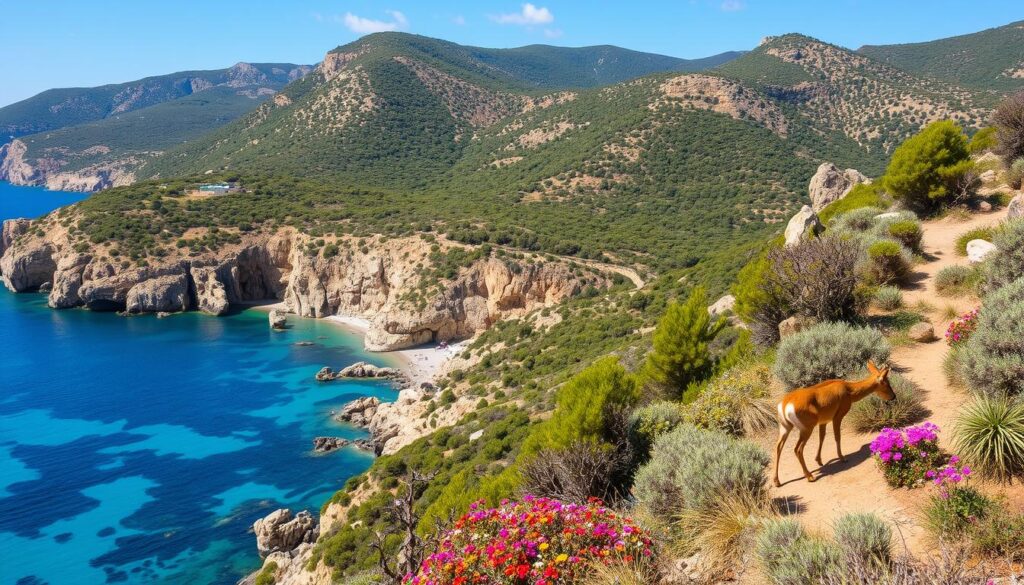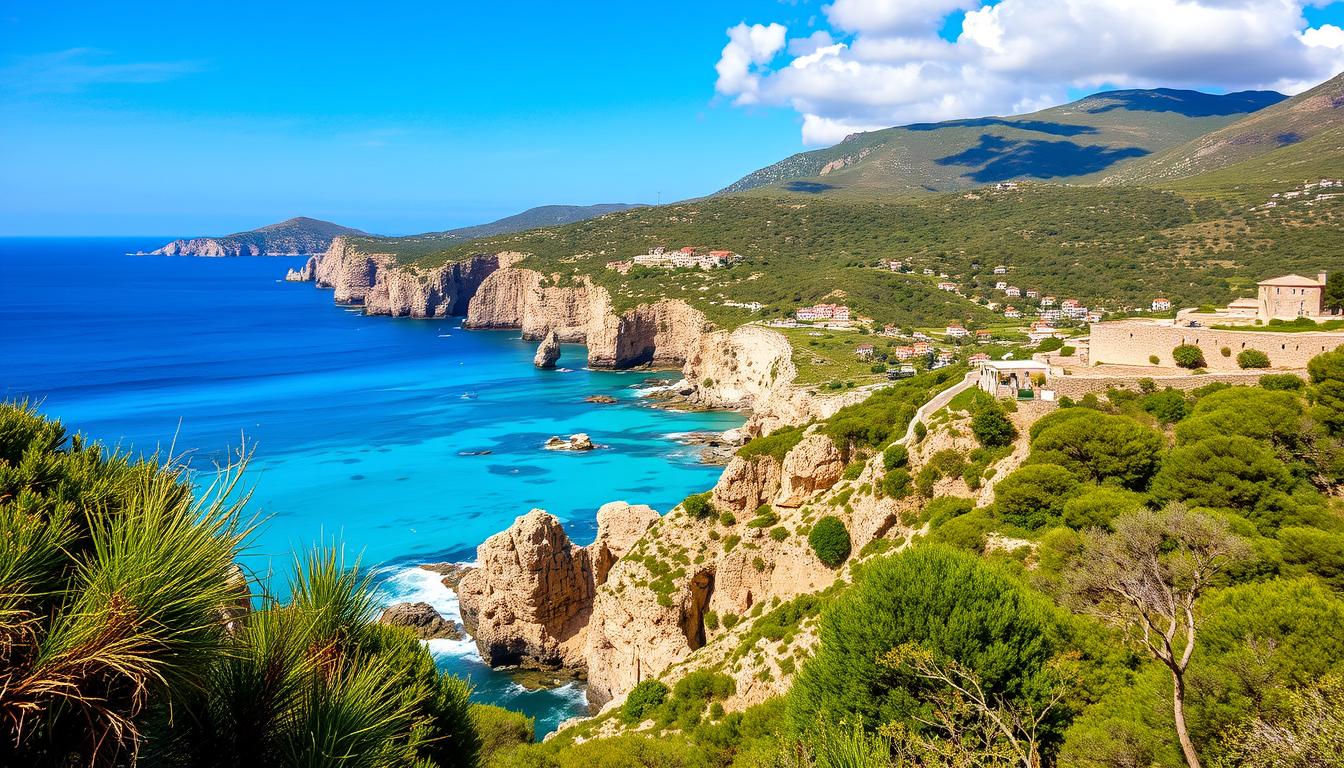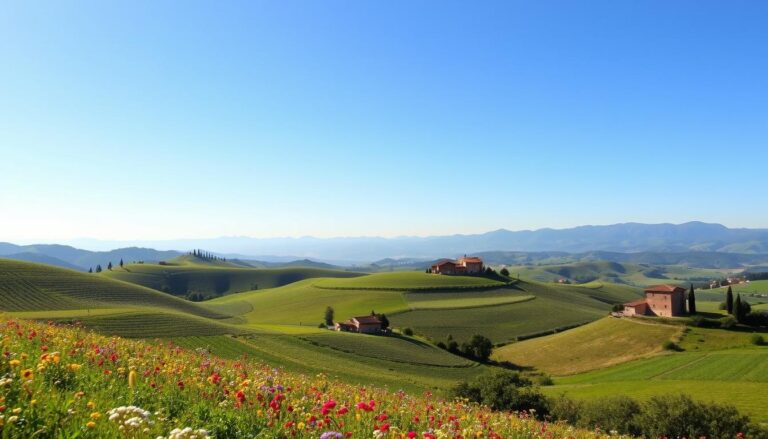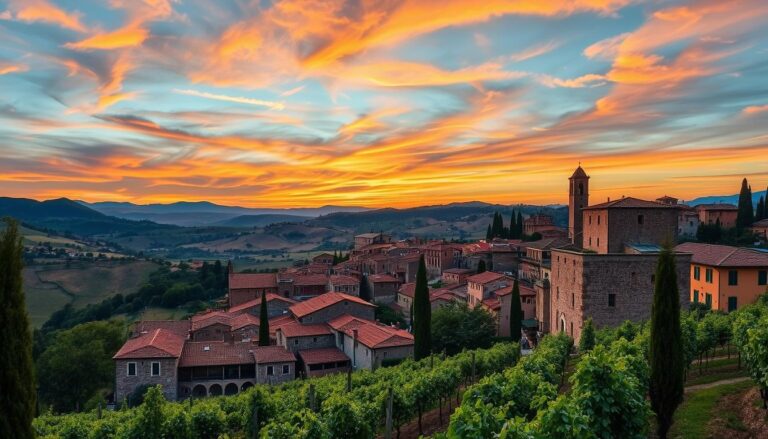Explore the Fascinating Island of Sardinia: Is It Part of Italy?
Ever dreamed of finding a Mediterranean paradise? Sardinia Italy is calling, with its mysterious charm and rich culture. This beautiful island, in the Mediterranean Sea’s heart, is more than just another Italian spot.
So, is Sardinia part of Italy? The answer is yes and no. It’s an autonomous region of Italy but has its own special identity. With a history dating back to the Stone Age, Sardinia lets you see ancient traditions meet modern life.
Sardinia’s stunning coastlines and deep cultural roots make it a Mediterranean history microcosm. Many civilizations, like the Phoenicians, Romans, and Aragonese, have shaped this island.
Ready to discover Sardinia’s story? It’s an island that challenges simple labels and invites you to explore its many sides within Italy.
Table of Contents
Understanding Sardinia’s Geography and Location
Sardinia is a captivating Italian island in the Mediterranean Sea. It’s the second-largest island in the western Mediterranean. The Sardinia region Italy is known for its stunning landscape, attracting travelers and geographers.
The Italian island Sardinia is about 120 miles west of mainland Italy. This unique position makes it stand out from other Mediterranean spots. It offers a blend of natural beauty and historical importance.
Where Is Sardinia Located?
Sardinia covers 9,301 square miles, with diverse terrain. It’s between 40° and 39° north latitude and 8° and 9° east longitude. This location gives it a unique Mediterranean climate.
- Distance from mainland Italy: 200 kilometers
- Distance from Corsica: 12 kilometers
- Coastal length: 1,850 kilometers
Proximity to Other Mediterranean Islands
Sardinia’s location is fascinating, connecting it to other Mediterranean areas. It’s close to several important islands and coastal spots, including:
- Approximately 200 kilometers from Tunisia
- Around 300 kilometers from the French Riviera
- Close proximity to the Balearic Islands
Overview of Sardinia’s Landscape
The landscape of Sardinia is stunning, with rugged mountains and beautiful coastlines. Mount La Marmora, the highest peak, is 6,017 feet tall. It shows the dramatic terrain of this remarkable island.
The island has extensive granite formations, especially in the eastern highlands. These formations make Sardinia’s topography unique. The varied terrain supports diverse ecosystems, offering visitors a unique natural experience.
Historical Context of Sardinia’s Identity
Sardinia’s history goes back thousands of years. It’s a mix of many civilizations that have made it special. The island’s story starts with ancient people who left behind amazing ruins.
Ancient Civilizations on the Island
The Nuragic civilization shows how deep Sardinia’s history is. From 1500-400 BCE, they built about 7,000 nuraghi. These stone towers show their advanced architecture and society.
- Over 80 buildings identified in nuraghic villages
- Complex social structures evident from archaeological evidence
- Distinctive stone construction techniques
Sardinia Under Roman Rule
The Romans took over Sardinia in 238 BCE. They won after a fight with Carthaginian mercenaries. The Sardinians kept fighting, showing their strong spirit.
| Year | Historical Event |
|---|---|
| 238 BCE | Roman Capture of Sardinia |
| 215 BCE | Roman Suppression of Rebellion |
| 181-114 BCE | Significant Sardinian Uprisings |
The Role of Sardinia in the Middle Ages
In the Middle Ages, Sardinia saw many changes. Vandal attacks in 429 CE and Lombard influence in the 720s made it a key place. By 815, Sardinians were making deals with Frankish emperors, showing their importance.
The island’s role kept changing, with Arabs coming and politics shifting. These events have made Sardinia’s culture unique in Italy.
Sardinia’s Political Status
Exploring Sardinia’s politics reveals a unique spot within Italy. It has a lot of freedom to govern itself. Yes, Sardinia is part of Italy, but it has special rules that make it stand out.
The Sardinia region in Italy has its own special way of governing. It’s one of Italy’s five areas with a lot of freedom. This shows its deep history and culture.
Autonomous Region Characteristics
Sardinia’s freedom to govern is unique. It has special powers that make it different from other Italian areas. Here are some key points:
- A Regional Council with 60 elected members
- Five-year election terms for regional representatives
- A Regional Government with 12 ministers
- Presidential representative democracy framework
Relationship with Italian Government
Sardinia is part of Italy but has a lot of freedom. It works well with the national government. This creates a balanced political setup.
Legal Framework and Governance
The latest election in February 2024 showed Sardinia’s strong democracy. With 736,186 votes and 1,447,753 registered voters, it was a big event.
Sardinia is divided into 377 towns, with Cagliari as the capital. This setup ensures local voices are heard while staying connected to Italy.
Cultural Heritage of Sardinia
Explore the lively culture of Sardinia, where old traditions and special customs weave a colorful picture of life on an Italian island. Sardinia Italy gives visitors a rare look into a rich cultural world that has stayed true to its roots for centuries.
Traditional Sardinian Crafts
Sardinian artisans keep alive remarkable traditional crafts that link today to a deep historical past. Key craft traditions include:
- Intricate textile weaving with ancient techniques
- Handcrafted silver filigree jewelry
- Ceramic production with distinctive local designs
- Woodcarving representing Nuragic cultural symbols
Colorful Sardinian Festivals
The island is filled with lively festivals that show off its unique culture. Sa Sartiglia, a traditional carnival in Oristano, is a standout. It’s a spectacular equestrian event with masked performers showing off their amazing horsemanship skills.
Culinary Delights
Sardinia’s food scene mirrors its special heritage. Some must-try local dishes include:
- Porceddu (traditional roasted suckling pig)
- Seadas (sweet cheese-filled pastry)
- Pecorino Romano cheese
- Cannonau wine with ancient grape varieties
Linguistic Diversity
The Sardinian language is a treasure in Sardinia Italy. It has roots before standard Italian, with unique dialects that show the island’s complex cultural history.
Tourism in Sardinia
Sardinia tourism in Italy is a unique getaway to a Mediterranean paradise. This Italian island Sardinia invites you with its varied landscapes, clean beaches, and rich culture. It offers memories that last a lifetime.
Exploring Sardinia shows a world of amazing places and fun activities. You can enjoy golden beaches or explore rugged mountains. The island has something for everyone.
Popular Tourist Destinations
- Costa Smeralda: A luxurious coastal stretch known for crystal-clear waters
- Cagliari: The vibrant capital city with historic charm
- La Maddalena Archipelago: A stunning national park with pristine islands
- Alghero: A charming city with Spanish architectural influences
Exciting Activities and Adventures
- Beach relaxation on Poetto Beach’s five-mile golden shoreline
- Hiking in Gennargentu National Park with 53 diverse trails
- Exploring archaeological sites like Su Nuraxi UNESCO World Heritage Site
- Windsurfing and diving in Mediterranean waters
Best Times to Visit Sardinia
The best time to visit Sardinia is from May to October. June to September is the peak season with the best weather.
| Season | Temperature Range | Tourist Density |
|---|---|---|
| Summer (June-August) | 75-90°F | High |
| Spring/Fall (May, September-October) | 60-75°F | Low to Moderate |
Looking for relaxation or adventure? Sardinia tourism in Italy offers an amazing trip to a Mediterranean gem.
Wildlife and Natural Parks
Sardinia Italy is a paradise for nature lovers. Its unique landscapes are home to a wide variety of wildlife and natural beauty. The geography of Sardinia supports ecosystems that are truly remarkable.

The island has many protected areas that show off its ecological wealth. Let’s dive into the amazing wildlife and natural parks that make Sardinia a true gem.
Unique Flora and Fauna
Sardinia is home to many species found nowhere else. Some of these include:
- Sardinian deer (Cervus elaphus corsicanus)
- Albino donkeys of Asinara
- Wild horses of Giara di Gesturi
- Rare bird species like the Bonelli’s eagle
Notable Natural Parks
Sardinia’s natural parks are stunning and crucial for conservation. Some of the key parks are:
- Asinara National Park: Covers 51 square miles with over 90 bird species
- Monte Arcosu: Protects extensive forests and rare Sardinian deer
- Molentargius-Saline Regional Park: A birdwatcher’s paradise with flamingo habitats
- Giara di Gesturi: Home to unique wild horses and endemic plants
Conservation Efforts
Efforts are in place to protect Sardinia’s endangered species. These programs aim to preserve wildlife, prevent habitat loss, and keep the ecosystem balanced. This balance is what makes Sardinia’s natural environment so unique.
If you love wildlife photography, nature, or eco-tourism, Sardinia’s natural parks are a must-see. They offer a chance to explore one of the Mediterranean’s most diverse and protected ecosystems.
Sardinia’s Economy
The Sardinia region in Italy has a unique economy. It has a population of about 1.6 million. The island balances many industries well.
Key Industries Driving Economic Growth
Sardinia’s economy is strong thanks to several key sectors:
- Tourism: A major economic driver
- Agriculture: Uses traditional and sustainable methods
- Service sector: Growing government and private services
- Manufacturing: Offers a wide range of industrial capabilities
Tourism: The Economic Powerhouse
Tourism is a big part of Sardinia’s economy. The island draws millions of visitors each year. This brings in a lot of money and creates jobs in coastal and inland areas.
Agriculture and Livestock: Traditional Economic Pillars
Agriculture is a key sector in Sardinia. The island’s natural beauty supports many farming activities:
| Product | Economic Significance |
|---|---|
| Wheat | Primary grain production |
| Grapes | Wine production |
| Sheep | Livestock and dairy industry |
| Olives | Oil production |
Sheep farming is also important in Sardinia’s economy. The island’s vast pastures support a strong farming tradition. This tradition helps both local and national economies a lot.
Sardinia’s economy is changing and growing. It combines old industries with new ones like tourism and services.
Transportation in Sardinia
Planning your trip to Sardinia Italy means getting to know the island’s transport options. Sardinia, a Mediterranean treasure, has many ways to see its stunning landscapes. Whether you’re coming from mainland Italy or looking for local travel, there’s a transport method for everyone.
Arriving in Sardinia: Flights and Ferries
Getting to Sardinia is an adventure. The island has three main airports in:
- Cagliari
- Olbia
- Alghero
Big European cities like London, Madrid, Paris, Frankfurt, and Vienna have direct flights. ITA Airways and Ryanair offer many daily flights from Rome and Milan.
Ferry Connections to the Island
Ferries are another fun way to reach Sardinia. The island is connected to mainland Italy by several ports, with key routes from:
- Genoa to Olbia
- Livorno to Olbia
- Civitavecchia to Olbia and Cagliari
Local Transportation Options
Getting around Sardinia is easy with various transport choices:
| Transportation Type | Coverage | Speed Limit |
|---|---|---|
| Highways (Superstrade) | Major routes | 110 km/h |
| Provincial Roads | Regional connections | 50-90 km/h |
| Train Networks | Trenitalia and ARST | Varied routes |
Car rentals are popular, with parking costing €1-2 per hour in cities. For public transit, trains and buses link major towns well.
Tips for Travelers
Here are some tips for exploring Sardinia:
- Book transport early in summer
- Check ferry and flight times carefully
- Think about renting a car for freedom
- Use public transit for saving money
Remember, Sardinia’s transport options suit all travelers’ needs and budgets.
Arts and Music in Sardinia
Sardinia Italy is known for its vibrant arts scene. It shows off the island’s deep cultural roots. From ancient stone carvings to modern art, Sardinia’s creativity shines through.
The arts in Sardinia are deeply connected to its history. The island is home to about 8,000 ancient stone towers (nuraghi). These structures link the island’s art to its prehistoric past.
Traditional Sardinian Music and Instruments
Sardinia’s music is truly unique. Its traditional instruments tell a lot about its culture:
- Launeddas: A special triple-reed wind instrument
- Organetto: A traditional accordion used in folk music
- Chitarra sarda: A traditional Sardinian guitar with unique tuning
The Influence of Arts in Sardinian Culture
Art in Sardinia is more than just beauty. It shows a deep bond between nature and human creativity. It draws inspiration from ancient civilizations like the Nuragic people.
| Art Form | Significance |
|---|---|
| Stone Sculpture | Reflects thousand-year-old traditions |
| Textile Crafts | Intricate designs with STEM-like precision |
| Musical Traditions | Preserves cultural memory and identity |
Contemporary Artists from Sardinia
Today, Sardinian artists are exploring new ways to express themselves. Pinuccio Sciola is a great example. He shows how Sardinian art blends old traditions with new ideas.
Sardinia’s arts scene is alive and full of history. It mixes old traditions with modern creativity. Through music, sculpture, and textiles, Sardinian culture is a powerful force in the arts.
Challenges Faced by Sardinia
The Sardinia region in Italy faces big environmental and economic hurdles. It’s a unique island in the Mediterranean. It must deal with complex problems that affect its future.
The people of Sardinia are under a lot of environmental stress. This is mainly because of climate change and drought. Here are some key climate-related issues:
- A state of emergency was declared in February and July 2023 due to the worst drought in 20 years
- Average temperatures have reached well above 40°C during drought periods
- Water reservoirs are nearly empty despite water rationing efforts
Environmental Issues Affecting the Island
Climate change is changing Sardinia’s environment a lot. Drought conditions have been made twice as likely by human-induced environmental transformations. The island struggles with saving water and keeping farms going.
Economic Challenges and Opportunities
| Economic Sector | Impact | Potential Solutions |
|---|---|---|
| Agriculture | Severe drought limitations | Water conservation strategies |
| Tourism | Climate-related disruptions | Sustainable tourism development |
| Infrastructure | Need for climate resilience | Adaptive infrastructure investments |
The Future of Sardinia’s Autonomy
The environmental and economic problems will affect Sardinia’s status in Italy. To solve these, new ideas and plans are needed. This will help keep the island sustainable and strong economically.
Experts say that without cutting greenhouse gas emissions, droughts will get worse by 2050. This is a big problem for Sardinia in Italy.
Comparison with Other Italian Regions
Sardinia is a unique Italian island with its own special features. It is one of Italy’s five autonomous regions. This makes Sardinia Italy a fascinating place for visitors and researchers.
Exploring if Sardinia is part of Italy reveals its unique qualities. The island has several standout features:
- Distinctive linguistic heritage with the Sardinian language
- Exceptional autonomous political status
- Unique cultural traditions preserved through centuries
- Breathtaking landscapes unlike other Italian regions
Cultural Distinctiveness
Sardinia’s culture is different from mainland Italy. The island’s traditions, crafts, and social practices show a rich history. Unlike other Italian regions, Sardinian communities keep strong ties to their pre-Roman past.
Political Autonomy
Sardinia has a special autonomous status in Italy. This gives the island more self-governance than other Italian regions. Sardinia can keep its unique culture while being part of Italy.
Geographical and Economic Uniqueness
Sardinia is unique in its economic structure and geography. Its rugged terrain and Mediterranean location offer different economic opportunities. The island’s economy combines traditional sectors like agriculture and fishing with modern tourism and specialized industries.
Comparative Regional Insights
Sardinia is less crowded than places like Lombardy. The island’s most populated areas are around Cagliari, Olbia, and Alghero. This creates a different demographic picture than mainland Italian cities.
Conclusion: Sardinia’s Identity Within Italy
Exploring Sardinia Italy reveals an island that’s hard to categorize. Yes, it’s part of Italy, but it has its own unique culture and language. Over 1.1 million people speak Sardinian, showing a strong identity that goes beyond usual boundaries.
Sardinia’s tourism scene is more than just its stunning views. It’s a place where culture and pride come alive. With 75% of locals valuing their language, Sardinia shows a strong commitment to its heritage while being part of Italy.
Visiting Sardinia is like stepping into a world where history meets modern Italy. You can explore UNESCO sites, taste local foods, or join in on festivals. It’s a journey that promises unforgettable moments.
Sardinia is a place that challenges what we think we know. It’s Italian but also uniquely its own. It’s a destination that offers real cultural experiences. Get ready to be captivated by an island that’s both Italian and distinct.
Recap of Sardinia’s Historical and Cultural Importance
Learn more about Sardinia’s story of cultural strength. In 2020, only 35% of people saw themselves as just Italian, down from 45% in 2000. The Sardinian language is a key part of this unique culture.
Final Thoughts on Sardinia’s Status
Sardinia is a shining example of Italy’s cultural diversity. Its autonomy helps keep traditions alive while staying connected to Italy. It’s a fascinating example of how regional identity can enrich Italy’s cultural tapestry.
Why Sardinia Should Be on Your Travel List
Sardinia is a must-see destination. It offers breathtaking landscapes, a rich history, and a vibrant culture. From ancient ruins to the Mediterranean coast, Sardinia promises adventures that will change how you see Italy.








One Comment
Comments are closed.